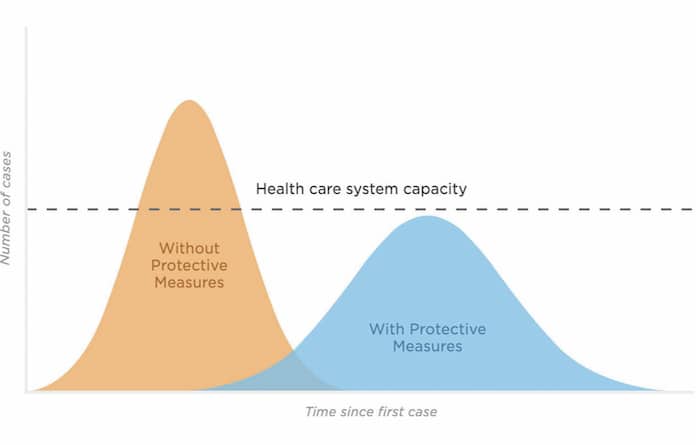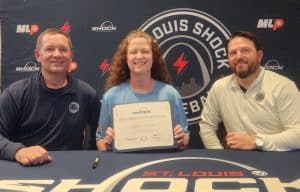Residents urged to ‘flatten the curve’

As the entire country adjusts to life with coronavirus, many people have many questions.
At a time like this, it is critical that individuals get the answers to those questions from reliable sources.
That means health care experts like the Centers for Disease Control and Prevention, World Health Organization, Illinois Department of Public Health and Monroe County Health Department.
It also includes trusted national, state and local news outlets like the Republic-Times.
It does not include sources like unverified social media posts or rumors.
For this story, the Republic-Times used information from those reputable sources to give readers a place to answer some basic questions about COVID-19.
What is COVID-19?
“COVID-19 is the infectious disease caused by the most recently discovered coronavirus,” the WHO reports. “This new virus and disease were unknown before the outbreak began in Wuhan, China, in December 2019.”
It is not simply a common cold or flu. While the fatality rate is difficult to determine, it appears to be as high as 4 percent or as low as 1 percent.
By contrast, seasonal flu has a fatality rate of about .1 percent, according to Harvard Medical School’s Coronavirus Resource Center.
What are the symptoms?
According to the CDC, the majority of patients with COVID-19 have mild to severe respiratory illness with fever, cough and difficulty breathing.
The WHO also reports that some patients may have tiredness, aches and pains, nasal congestion, a runny nose, sore throat or diarrhea. Those are usually mild and begin gradually.
About 80 percent of people recover from the disease without needing special treatment, but older individuals and those with underlying medical problems are more likely to develop a serious illness.
People can also have the virus without having any symptoms. Those individuals can still spread the sickness to others.
How is the virus spread?
“The virus that causes COVID-19 seems to be spreading easily and sustainable in the community in some affected geographic areas,” the CDC reports. “Community spread means people have been infected with the virus in an area, including some who are not sure how or where they became infected.”
It appears the disease most commonly spreads from person to person through small droplets from the nose or mouth that are spread when a person with the virus coughs or exhales.
People can also catch COVID-19 by touching objects or surfaces those droplets land on, then touching their eyes, nose or mouth.
Is there a cure?
No vaccine or drug treatment is currently available for the virus, though work has begun to develop one. But experts expect that could take a year or more.
How long will the precautionary restrictions last?
While a vaccine may not be available for several months, that does not mean the current measures enacted by the federal, state or local government will also last that long.
Exactly how long they will last is unknown, as that depends on a variety of factors like how much we can slow the spread of the virus.
Why are all these measures in place?
At this point, the goal is not to stop coronavirus from spreading, but to slow its spread to ensure the medical system is not overwhelmed and life is not upended even more.
“There’s every chance that we could be Italy,” U.S. Surgeon General Jerome Adams warned on Monday.
Italy has virtually placed its entire population of about 60 million people under house arrest in an effort to slow the virus down.
COVID-19 has killed over 2,100 and infected thousands more in that first-world nation, overwhelming the health care system.
Hospitals have erected inflatable, sealed-off infectious disease tents on their grounds and doctors are being forced to choose who receives potentially life-saving care and who dies.
By implementing bans on gatherings, closing public places and advising social distancing, the United States is looking to do what social media has termed “flatten the curve.”
That comes from a widely shared graph from a CDC study that shows how delaying the spread of the virus can ensure the health care system does not meet its capacity.
How can I protect myself from the coronavirus and help prevent its spread?
Individuals can take precautionary measures of their own like regularly and thoroughly washing their hands with soap and water or an alcohol-based sanitizer, maintaining at least six feet between other people to avoid infected droplets, avoid touching their face, covering their coughs and sneezes with a tissue or the inside of their elbow, cleaning and disinfecting frequently touched surfaces and staying home and away from public places as much as possible.
That last step is crucial for everyone because not doing so can cause the virus to spread exponentially.
One social media post that has been widely shared and is true is a quote from Michael Leavitt at a conference on the pandemic flu in 2007.
“Everything we do before a pandemic will seem alarmist,” the former secretary of the U.S. Department of Health and Human Services under President George W. Bush and President Barack Obama said. “Everything we do after a pandemic will seem inadequate.”
That must also be balanced with a desire to do things like support businesses and individuals in the community.
What do I do if I think I have COVID-19?
If you are experiencing symptoms of COVID-19, do not go to the doctor.
Instead, call your health care provider so they can ask you a series of questions to determine if you should be tested for the illness.
If you have symptoms of the virus, it is even more important to self-isolate at home from both the community and those you live with.






